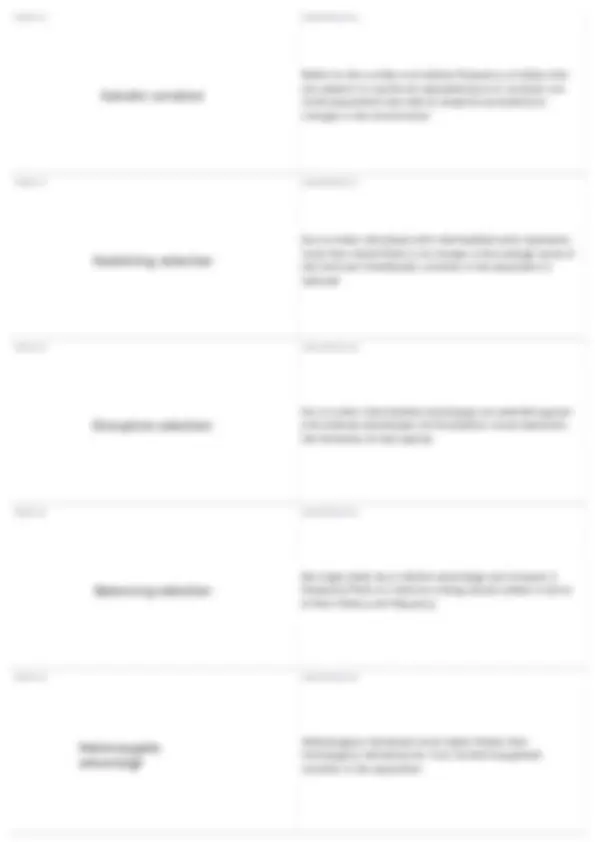





Study with the several resources on Docsity

Earn points by helping other students or get them with a premium plan


Prepare for your exams
Study with the several resources on Docsity

Earn points to download
Earn points by helping other students or get them with a premium plan
Community
Ask the community for help and clear up your study doubts
Discover the best universities in your country according to Docsity users
Free resources
Download our free guides on studying techniques, anxiety management strategies, and thesis advice from Docsity tutors
Definitions for key terms and concepts in the field of population genetics, including population, gene pool, allele frequency, genotype frequency, phenotype frequency, microevolution, macroevolution, hardy-weinberg equilibrium, genetic drift, genetic variation, stabilizing selection, disruptive selection, balancing selection, heterozygote advantage, gene flow, mutation, non-random mating, assortative mating, disassortative mating, inbreeding, inbreeding depression, and sexual selection.
Typology: Quizzes
1 / 7

This page cannot be seen from the preview
Don't miss anything!




Refers to the study of evolution via the observation and modeling of allele frequencies and genetic change in populations of organisms TERM 2
DEFINITION 2 The total of all genes in the population at any one time TERM 3
DEFINITION 3 The proportion of a specific allele at a given locus, considering that the population may contain from one to many alleles at that locus TERM 4
DEFINITION 4 a population TERM 5
DEFINITION 5 The proportion of a specific genotype at a given locus, considering that many different genotypes may by possible
The proportion of individuals in a population that exhibit a given phenotype TERM 7
DEFINITION 7 Applies to small genetic changes due to changing allelic frequencies in populationsOccurs continuouslyCan transform into macroevolution TERM 8
DEFINITION 8 Refers to genetic change that is sufficient to form a new speciesCan happen gradually TERM 9
DEFINITION 9 A lineage that appears to remain the same over time TERM 10
DEFINITION 10 A population that is not changing geneticallyNo natural selectionNo genetic drift or random allele frequency changesNo gene flowNo mutationRandom matingLarge PopulationA violation of one or more = evolved population
Refers to the number and relative frequency of alleles that are present in a particular populationLack or variation can make populations less able to respond successfully to changes in the environment TERM 17
DEFINITION 17 Occurs when individuals with intermediate traits reproduce more than othersThere is no change in the average value of the trait over timeGenetic variation in the population is reduced TERM 18
DEFINITION 18 Occurs when intermediate phenotypes are selected against and extreme phenotypes are favoredCan cause speciation, the formation of new species TERM 19
DEFINITION 19 No single allele has a distinct advantage and increase in frequencyThere is a balance among several alleles in terms of their fitness and frequency TERM 20
DEFINITION 20 Heterozygous individuals have higher fitness than homozygous individuals do, thus maintaining genetic variation in the population
Any change in allele frequencies in a population due to change (sampling error). Occurs in every population, in every generation.Causes allele frequencies to drift up and down randomly over timeUsually reduces average fitnessRandom with respect to fitnessMost pronounced in small populations TERM 22
DEFINITION 22 Bottleneck effectFounder effect TERM 23
DEFINITION 23 May lead to reduce genetic variability following some large disturbance that removes a large portion of the population. The surviving population often does not represent the allele frequency in the original population TERM 24
DEFINITION 24 May lead to reduced variability when a few individuals from a large population colonize an isolated habitat TERM 25
DEFINITION 25 The movement of alleles from one population to another, occurs whenever individuals leave one population, join another, and breedMay increase or decrease average fitness
A decline in average fitness that takes place when homozygosity increases and heterozygosity decreases in a population TERM 32
DEFINITION 32 No because allele frequencies do not change in the population as a whole TERM 33
DEFINITION 33 Occurs when individuals within a population differ in their ability to attract mates. Favors individuals with heritable traits that enhance their ability to obtain matesLeads to evolutionResponsible for the phenotypic differences between males and females TERM 34
DEFINITION 34 Any trait that differs between males and females of the same speciesMale and female lions